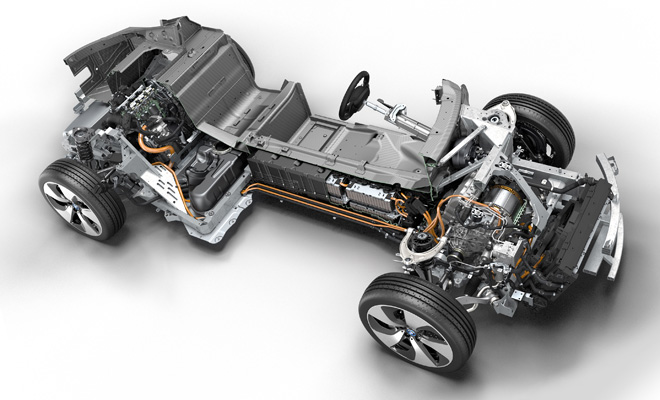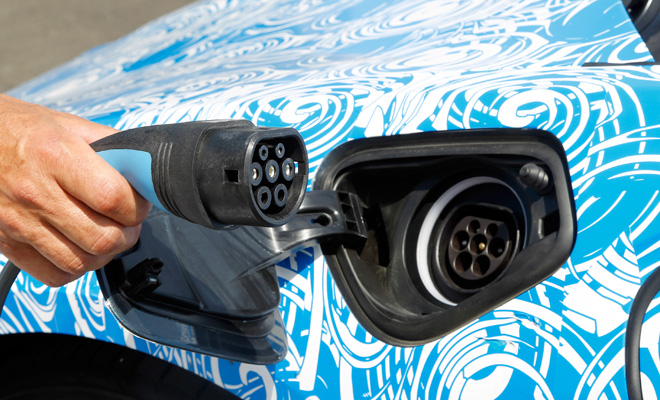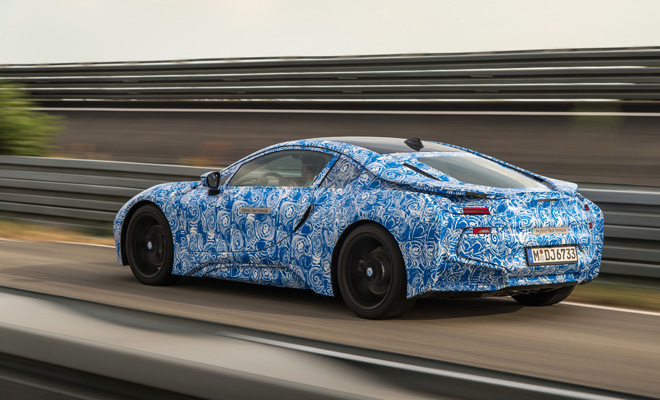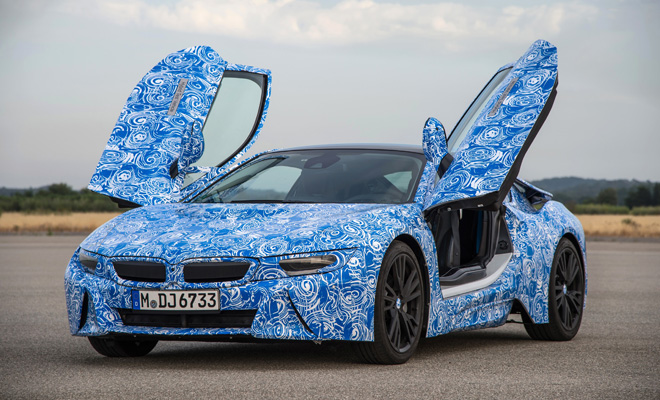by Antony Ingram 
Following the launch of BMW’s first dedicated production electric car, the i3, focus now turns to an even more exciting vehicle from the Bavarian marque – the i8.
Well, more exciting for some, at least. Unlike the all-electric, occasionally range-extended i3, the i8 sports car is a less contentious plug-in hybrid model. And as an overtly sporting car, it sits more comfortably with BMW’s existing brand reputation. It could play an important role in convincing people in general – and even a few petrolheads – that going electric need not be a bad thing.
Here are ten things you need to know about the new i8.
1. You’ll see it soon
Like the smaller i3, the i8’s gestation has been long and profoundly public. Rarely have supposedly secret products been more visible than this pair, but while we now know the i3’s final form, the i8’s true curves and creases are still shrouded under the final layers of BMW’s swirly blue camouflage.
You won’t have too much longer to wait, though, as BMW has confirmed the i8 will make its disguise-free debut at the Frankfurt Motor Show in September. It’s sure to be a stunner.

2. It has an important engine
It may seem strange singling out the BMW’s 1.5-litre, three-cylinder petrol engine for praise rather than its electric drivetrain, but there’s method behind the madness.
This engine is an important one for BMW. Far from being hidden away amidships in the i8, the turbocharged unit will take a broad role providing power for the next-generation Mini, BMW’s impending front-wheel drive family car, and most probably the next 1-Series and 3-Series models too, in various states of tune.

3. It really does have an important engine
BMW is German, but the i8 will have a British heart. The company already makes engines in the UK, and the new three-cylinder will be no different – it’s to be built at BMW’s engine plant at Hams Hall, near Birmingham.
The plant was opened back in 2001 and widespread use of the new three-pot motor will ensure it has a long future ahead of it too. So the i8’s engine will not only go on to power a new generation of greener BMWs, but it will support hundreds of British jobs for years to come.
4. Performance? Yep, it will have that
It’s small, it’ll power a whole heap of future BMWs, and it’s built in Britain. But what else matters about the new three-cylinder engine? It’s powerful, too, boasting 231 horsepower and 236lb-ft of torque, for the highest specific output of any road-going BMW engine so far.
Combine that with the i8’s 131hp, 184lb-ft electric motor and you’ve a combined system output of 362 horses and 420lb-ft . Rest to 60 mph will be dusted in “under 4.5 seconds”, 50 to 75mph in a similar couple of blinks, and the top speed will need to be capped at 155 mph. So yes, it should be quick.

5. It’s efficient, too
The i8’s plug-in hybrid drivetrain would amount to mere posturing if BMW couldn’t back it up with some solid range and economy numbers.
If those numbers are correct, then the i8 could prove compellingly cheap to run. The i8’s lithium-ion battery pack, mounted down its spine, is good for 20-odd miles of range. Throw in petrol power and that range extends to “over 310 miles”, while combined-cycle economy is in the 114mpg region.
This is subject to more variable factors than you can shake a blue and white propeller at, of course. Real-world fuel efficiency will largely depend on how much time can be spent under electrical propulsion.

6. It should drive like a proper BMW
Initial feedback from early drives in i3 prototypes has been mixed, but there should be less of a split when the i8 hits the streets.
Making a low-slung sports car handle like a low-slung sports car should be much easier than doing the same with a tall, narrow city car on skinny tyres – and BMW promises its usual 50:50 weight distribution, front to rear. It’d be hugely surprising if the engineers manage to mess this one up.
7. It won’t weigh much
Handling, performance and economy should all be enhanced by one factor in particular – the i8’s mass. A quoted kerb weight of 1,490 kg makes it a featherweight compared to BMW’s normal coupés, despite the presence of all those batteries, electronics and motors – the current 6-Series starts at 1,735 kilos and only gets more lardy from there.
The i8’s strong carbon-fibre and aluminium construction can be thanked for this, just as it can for the relatively modest weight of the i3. Ditto the interior’s heavy use of magnesium and foam plastic, chopping dozens of kilos from the mass of an equivalent 6-Series cabin.

8. It’ll be as slippery as a fish
BMW has worked hard to ensure the i8 slides through the air with minimal fuss. BMW says it has “finely honed airflow around all parts of the vehicle body”, meaning low drag, low lift and maximum aerodynamic efficiency.
Relatively tall, narrow wheels will no doubt play a part, as will the slick surfaces of the alloy wheels themselves. A near-flat undertray is a given, and unique details like the i8’s wing-like rear lights will also have seen a wind tunnel or two. The upshot is a drag coefficient of 0.26, among the sleekest production cars ever to turn a wheel.
9. Clever technology returns
It’s easy to think of the i8 as a gigantic smartphone. Not just thanks to the technology within, but because it’s the first production car to use 0.7 mm-thick, lightweight, chemically-hardened glass between the passenger compartment and boot.
You might be more familiar with it as the sort of glass commonly used for smartphone and tablet screens – light, strong and thin. BMW’s smartphone-like ConnectedDrive technology is also on the cards, while a series of different driving modes and BMW’s ubiquitous Eco Pro functions should let you tailor every aspect of your journey.

10. It won’t be cheap
There’s no official word on pricing yet, but all this technology won’t come cheap. Figures as high as £100,000 have been thrown around, but following the i3’s surprisingly low price tag, we’re hoping the i8 will arrive with a similar how-do-they-manage-that price.
BMW i8 – 10 things to expect from BMW’s sports hybrid
20 August 2013
Read more about: BMW BMWi hybrids plug-in cars








